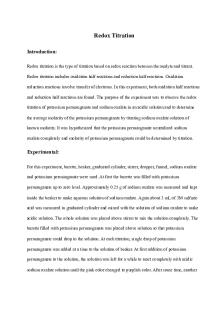Chemical Analysis by Redox Titration PDF

| Title | Chemical Analysis by Redox Titration |
|---|---|
| Author | pakMEISTER |
| Course | General Chemistry |
| Institution | Purdue University |
| Pages | 2 |
| File Size | 60.6 KB |
| File Type | |
| Total Downloads | 107 |
| Total Views | 160 |
Summary
Lab report...
Description
Chemical Analysis by Redox Titration
Purpose of Experiment: Analyze the percent hydrogen peroxide in a common “drugstore” solution by titrating it with potassium permanganate. Pre-Lab Questions: 1. Use the half-reaction method to write a balanced chemical equation for the overall reaction between H2O2 and MnO4 in acidic solution. a. MnO4-(aq) + 5e- + 8H+(aq) ⇒ Mn2+(aq) + 4H2O(l) b. H2O2(aq) ⇒ O2(g) + 2H+ (aq) + 2ec. 5H2O2 + 2MnO4- + 16H+ ⇒ 5O2 + 10H+ + 2Mn2+ + 8H2O d. 2MnO 4 - + 5H2 O + 6H+ ⇒ 2Mn2 + + 5O2 + 8H 2 O 2 2. What is the mole ratio of hydrogen peroxide to permanganate ion in the balanced chemical equation you determined in Question #1? How many moles of hydrogen peroxide will be oxidized by 0.0045 moles of potassium permanganate in acidic solution? a. Mole ratio of hydrogen peroxide to permanganate ion is 5:2, respectively. b. 0.005625 moles of hydrogen peroxide will be oxidized by 0.0045 moles of potassium permanganate in an acidic solution. 3. Review the procedure. Is it necessary to know the exact mass of: a. Hydrogen peroxide solution added to the flask in steps 7 and 8? i. It is necessary to know the exact mass of hydrogen peroxide solution added to the flask in steps 7 and 8. b. Water added to the flask in steps 8 and 9? i. It is not necessary to know the amount of water added to the flask in steps 8 and 9. c. Why or why not?
i.
Water is only present to dilute the solution - it does not affect the number of moles in any way. Hydrogen peroxide, however, affects the number of moles in the reaction.
Post-Lab Questions 1. Determine the mass percent of H2O2 in the commercial sample for each trial. a. 0.03998 L * (.1mol/1L) ⇒ 0.003998 mol i. 0.003998 mol * (34g / 1mol) ⇒ 0.1359g ii. 100% * (0.1359g/10.6812)g ⇒ 1.264% b. 0.03610 L * (.1mol/1L) ⇒ 0.003610 mol i. 0.003610 mol * (34g / 1mol) ⇒ 0.12274g ii. 100% * (0.12274g/9.5497g) ⇒ 1.285% c. 0.03713 L * (.1mol/1L) ⇒ 0.003713 mol i. 0.003713 mol * (34g / 1mol) ⇒ 0.126242g ii. 100% * (0.126242g/9.1964g) ⇒ 1.373% 2. Calculate the average percent of H2 O2 in the commercial sample. Compare this value to the concentration of H2O2 listed as the active ingredient on the product label. a. (1.373 + 1.285 + 1.264) / 3 = 1.307% H2Ω∫errO 2 b. Concentration of H2O2 listed as active ingredient on product label is 3%....
Similar Free PDFs

Redox Titration
- 21 Pages

Experiment 7 - Redox Titration
- 12 Pages

Lab 2 iron via redox titration
- 7 Pages

Vinegar Analysis via Titration
- 18 Pages

Redox
- 4 Pages

Redox Titrations
- 4 Pages

valoración redox
- 10 Pages
Popular Institutions
- Tinajero National High School - Annex
- Politeknik Caltex Riau
- Yokohama City University
- SGT University
- University of Al-Qadisiyah
- Divine Word College of Vigan
- Techniek College Rotterdam
- Universidade de Santiago
- Universiti Teknologi MARA Cawangan Johor Kampus Pasir Gudang
- Poltekkes Kemenkes Yogyakarta
- Baguio City National High School
- Colegio san marcos
- preparatoria uno
- Centro de Bachillerato Tecnológico Industrial y de Servicios No. 107
- Dalian Maritime University
- Quang Trung Secondary School
- Colegio Tecnológico en Informática
- Corporación Regional de Educación Superior
- Grupo CEDVA
- Dar Al Uloom University
- Centro de Estudios Preuniversitarios de la Universidad Nacional de Ingeniería
- 上智大学
- Aakash International School, Nuna Majara
- San Felipe Neri Catholic School
- Kang Chiao International School - New Taipei City
- Misamis Occidental National High School
- Institución Educativa Escuela Normal Juan Ladrilleros
- Kolehiyo ng Pantukan
- Batanes State College
- Instituto Continental
- Sekolah Menengah Kejuruan Kesehatan Kaltara (Tarakan)
- Colegio de La Inmaculada Concepcion - Cebu








